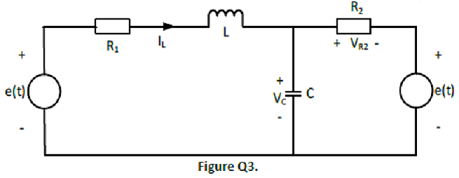Reference no: EM132358839
Question 1 - A digital filter is defined by the difference equation;
y(k) - 1.6065y(k - 1) + 0.6065y(k - 2) = u(k - 1) + u(k - 2)
a. Obtain the discrete time transfer function for the digital filter G(z).
b. Study how the filter G(z) handles the input signal u(n) = (-1)n1(n).
c. Plot the Bode diagram of G(z) using Matlab include the code in your answer. Validate the result from part a.
d. If G(z) is included in a closed loop system shown in Figure Q1, plot the Bode diagram for the closed loop system using Matlab and find phase margin and gain margin of the closed loop system. Assume K=1 and include the code in your answer.
e. Plot step response of the closed loop system and specify the overshoot, risetime, settling time and steady-state of the response.

Question 2 - a. Draw root locus diagram of the closed loop system shown in Figure Q1 and find the values of 0 < K < ∞ the system is stable.
b. Draw Nyquist diagram of the closed loop system shown in Figure Q1 and find the values of 0 < K < ∞ where the system is stable.
c. Draw the Bode diagram of the closed loop system shown in Figure Q1 and find the values of 0 < K < ∞ where the system is stable.
Question 3 - Find the following for the circuit shown in Figure Q3.
a. Write the continuous time state equations of the circuit.
b. Find transfer function G(s) = VR_2(s)/E(s) where E(s) = L{e(t)}.
c. Assume C = 0.2 F, L = 2 H, R1 = 100 Ω, R2 = 50 Ω. Find the ZOH equivalent discrete system in part a if sampling time is 1 s.
d. Find the transfer function G(z) in part b.
e. Find the zero-state step response (steady state) of the circuit to the input {e(n)}.
f. Find the zero input or transient response of the circuit when initial condition of the circuit is: Vc(0) = 4 V, IL(0) = 0.25 A.

Question 4 - a. Using pole-zero placement, design a filter G(z) that filters out the frequency ω0 = 2π/3 and at frequency ω = 0, G(1) = 1.5.
b. Show that if u(n) is the input and y(n) is the output of the filter G(z) in part a, y(n) can be written as, y(n) = b0u(n) - b1u(n - 1) - b2u(n - 2) and find the coefficient b0, b1 and b2.
c. Show that if u(n) = cosω0n (ω0 = 2π/3) is the input to G(z) then the output y(n) = 0. (Hint: use the equation cos A + cos B = 2 cos (A+B)/2 cos (A-B)/2).
d. Find the relationship between the phase angle of the filter and the frequency ω.
Question 5 - Answer the following questions about the diagram of a digital filter shown in Figure Q5.
a. Find the discrete time state equation of the diagram.
b. Find the transfer function of the diagram.
c. Find the inverse z-transform of the transfer function you found in part b.
